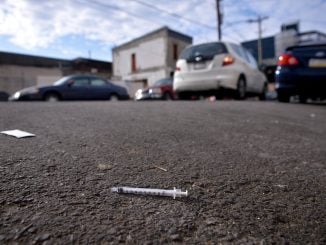
CLEVELAND — A jury’s finding that three major pharmacy chains are responsible for contributing to the scourge of opioid addiction in two Ohio counties may be just the beginning of a protracted legal battle that ultimately could leave the communities no better off.
The reason for the complications is the case’s central argument — that pharmacies created a “public nuisance” by dispensing an overwhelming quantity of prescription painkillers into each county.
Thousands of state and local governments have sued drugmakers, distributors and pharmacies over a crisis that has contributed to more than 500,000 overdose deaths in the U.S. over the past two decades. The lawsuits generally center on claims the companies created public nuisances by interfering with the rights of the public through the way they marketed, shipped and sold the drugs — feeding the addictions of some patients and providing pills later diverted to the black market.
Similar arguments were used in two other cases — in California and Oklahoma — that went in favor of the industry in the weeks before the Ohio jury’s decision. Given those decisions, there is no guarantee that the verdict in the case brought by Lake and Trumbull counties against CVS, Walgreens and Walmart will hold up on appeal or lead to similar decisions elsewhere.
The industry argues it did nothing illegal and that public nuisance laws simply don’t apply to prescribing and distributing prescription painkillers.
“As we have said throughout this process, we never manufactured or marketed opioids nor did we distribute them to the ‘pill mills’ and internet pharmacies that fueled this crisis,” Walgreens spokesperson Fraser Engerman said in a statement. “The plaintiffs’ attempt to resolve the opioid crisis with an unprecedented expansion of public nuisance law is misguided and unsustainable.”
Public nuisance claims are typically used to address local concerns like blighted homes, illegal drug-dealing or dangerous animals. Such claims were used in lawsuits states brought against tobacco companies in the 1990s, but those led to settlements rather than trials.
Lawyers representing the counties and other local governments involved in the broader universe of opioid lawsuits said the companies have been complicit in creating local public health emergencies by opening more locations, flooding communities with pills and facilitating the flow of opioids into a secondary market.
In Trumbull County alone, roughly 80 million prescription painkillers were dispensed between 2012 and 2016 — equivalent to 400 for every resident. In Lake County, it was some 61 million pills.
The pharmacy chains have vowed to keep fighting and see reason for optimism.
An Oklahoma judge ruled in 2019 that drugmaker Johnson & Johnson created a nuisance and ordered the company to pay the state $465 million. This month, the state Supreme Court rejected the verdict, saying Oklahoma’s public nuisance law didn’t apply to the opioid maker.
Also, a California judge ruled in favor of a group of drugmakers being sued under a public nuisance statute by county and city governments.
The Ohio case also is unique because it was the first of the U.S. opioid trials to be decided by a jury rather than a court, and the first on claims against pharmacies.
Elizabeth Burch, a University of Georgia law professor, said pursuing the cases on public nuisance grounds makes sense because the pharmacies were uniquely positioned to watch the addiction crisis develop.
“These are the folks that are on the front lines,” she said. “They’re seeing the same people coming in and they’re seeing the same doctors writing prescriptions.”
But she also noted that public nuisance statutes and case law vary by state and that factors such as a compelling lawyer can be enough to swing a verdict. That makes it uncertain whether a consensus will develop around the legal theory.
More tests of the public nuisance laws are on the horizon.
A federal judge in West Virginia heard a case against drug distributors earlier this year but has not yet ruled. Trials are ongoing against distributors in Washington state and manufacturers in New York.
Unlike companies in other segments of the drug industry, no pharmacy has entered into a nationwide settlement deal over the crisis. Joe Rice, one of the lead attorneys representing local governments in the cases, said he hopes the ruling prompts pharmacy chains to start reaching those settlements.
If they don’t, it could cost them even more. The two Ohio counties, for instance, are each seeking more than $1 billion in damages in a second phase of the trial that is expected to be held next April or May.
“We’re going to try a lot of cases and we’re going to lose some,” Rice said. “But we’re going to win this war.”


